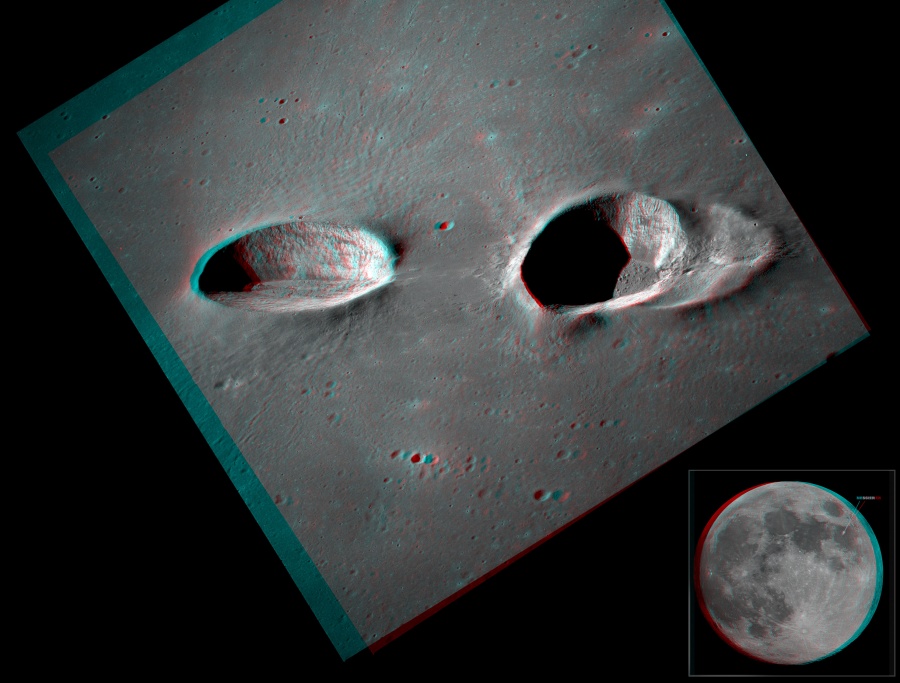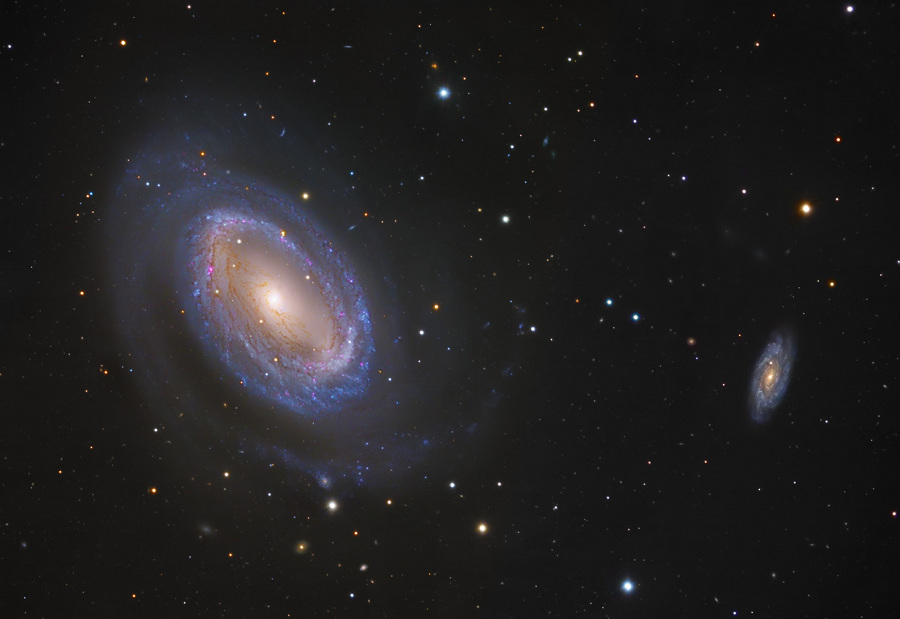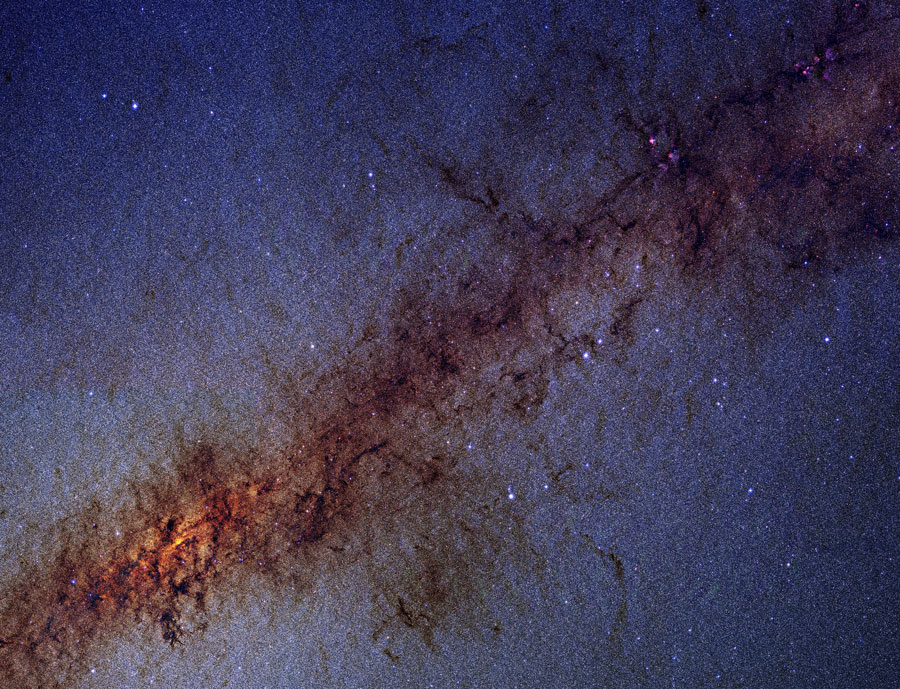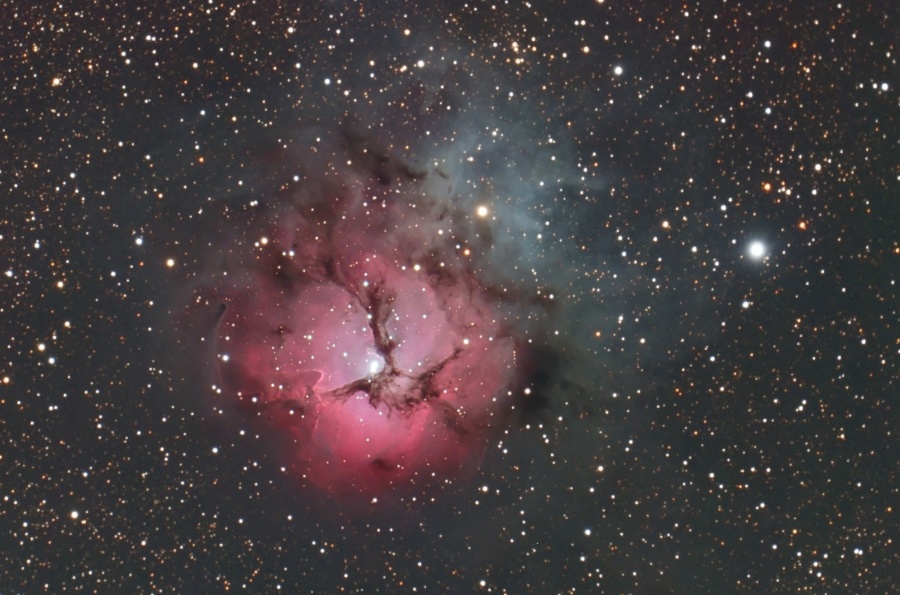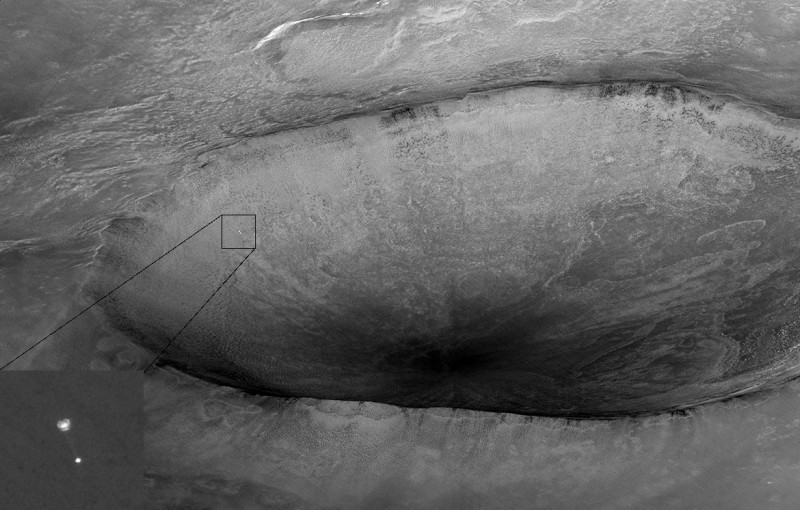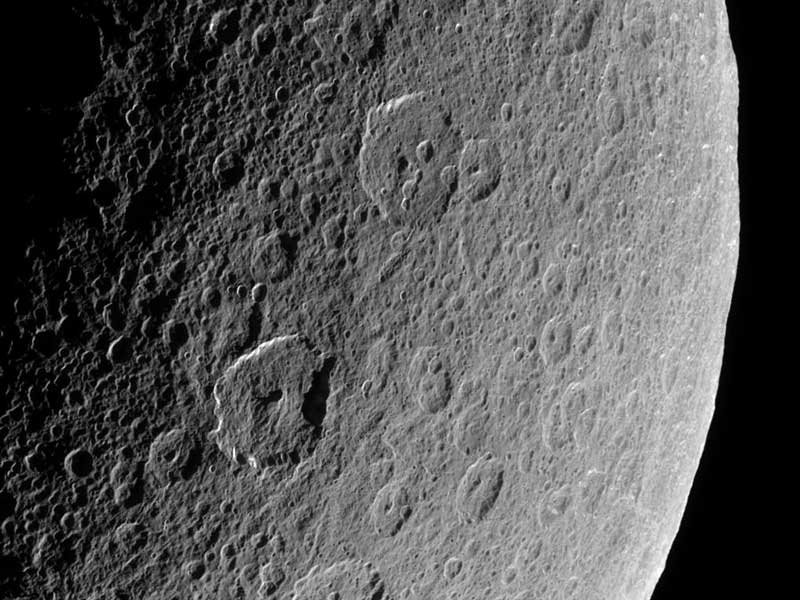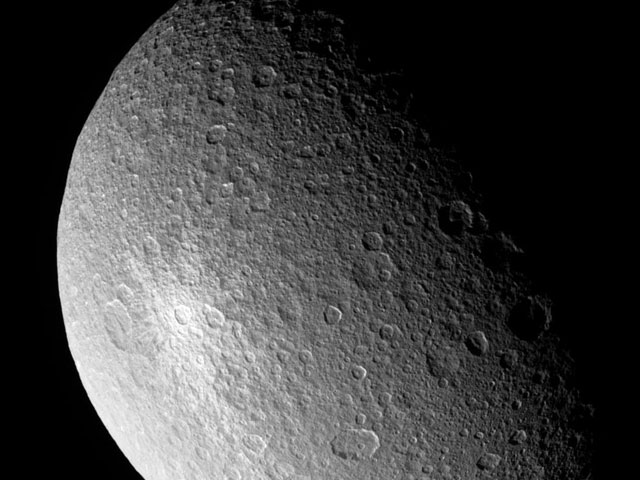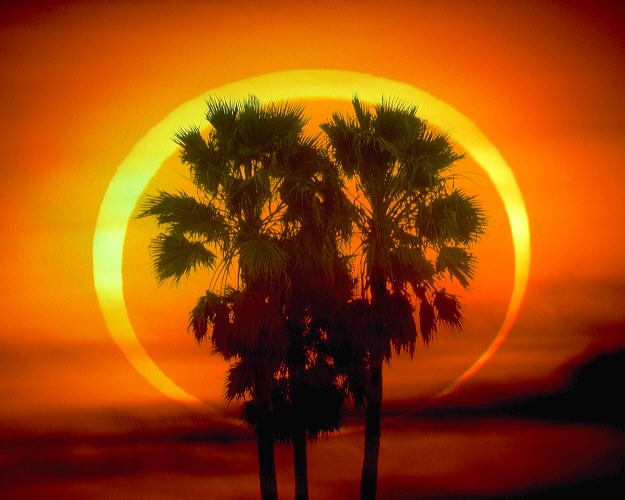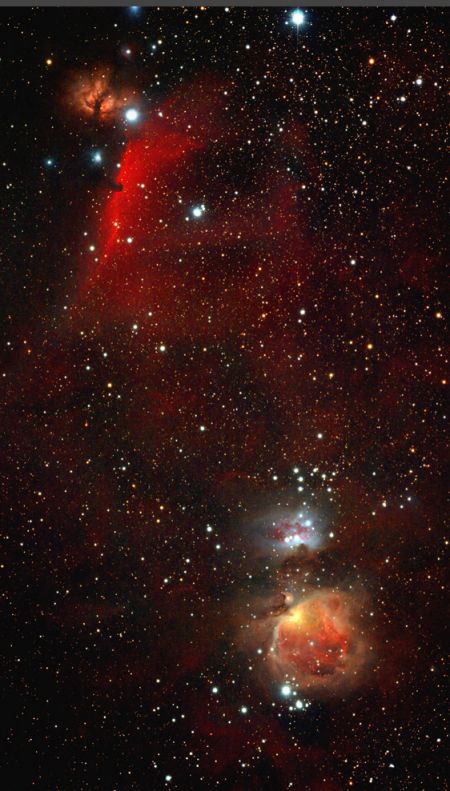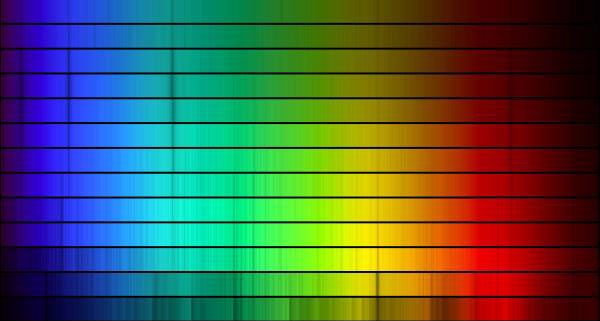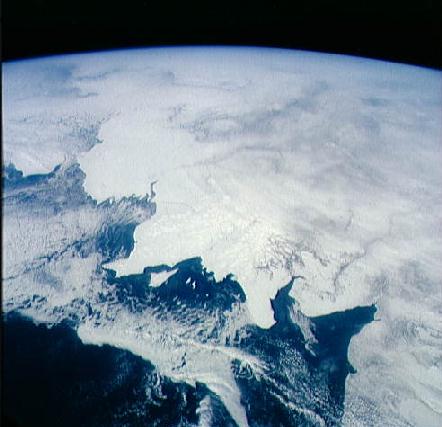| << Previous | Index | Next >> |
2015 Many bright nebulae and star clusters in planet Earth's sky are associated with the name of astronomer Charles Messier, from his famous 18th century catalog. His name is also given to these two large and remarkable craters on the Moon. Standouts in the dark, smooth lunar Sea of Fertility or Mare Fecunditatis, Messier (left) and Messier A have dimensions of 15 by 8 and 16 by 11 kilometers respectively. Their elongated shapes are explained by an extremely shallow-angle trajectory followed by the impactor, moving left to right, that gouged out the craters. The shallow impact also resulted in two bright rays of material extending along the surface to the right, beyond the picture. Intended to be viewed with red/blue glasses (red for the left eye), this striking stereo picture of the crater pair was recently created from high resolution scans of two images (AS11-42-6304, AS11-42-6305) taken during the Apollo 11 mission to the moon.
2014 The gorgeous, gaseous shroud of a dying sunlike star, planetary nebula Abell 36 lies a mere 800 light-years away in the constellation of Virgo. At that distance it spans over 1.5 light-years in this sharp telescopic view. Shrugging off its outer layers, the nebula's central star is contracting and becoming hotter, evolving towards a final white dwarf phase. In fact, in Abell 36, the central star is estimated to have a surface temperature of over 73,000 K, compared to the Sun's present 6,000 K temperature. As a result, the intensely hot star is much brighter in ultraviolet light, compared to its visual appearance here. The invisible ultraviolet light ionizes hydrogen and oxygen atoms in the nebula and ultimately powers the beautiful visible light glow.
2013
2012 What's that dark spot on planet Earth? It's the shadow of the Moon. The above image of Earth was taken last week by MTSAT during an annular eclipse of the Sun. The dark spot appears quite unusual as clouds are white and the oceans are blue in this color corrected image. Earthlings residing within the dark spot would see part of the Sun blocked by the Moon and so receive less sunlight than normal. The spot moved across the Earth at nearly 2,000 kilometers per hour, giving many viewers less than two hours to see a partially eclipsed Sun. MTSAT circles the Earth in a geostationary orbit and so took the above image from about three Earth-diameters away. Sky enthusiasts might want to keep their eyes pointed upward this coming week as a partial eclipse of the Moon will occur on June 4 and a transit of Venus across the face of the Sun will occur on June 5.
2011
2010 The center of our Galaxy is a busy place. In visible light, much of the Galactic Center is obscured by opaque dust. In infrared light, however, dust glows more and obscures less, allowing nearly one million stars to be recorded in the above image. The Galactic Center itself appears glowing on the lower left and is located about 30,000 light years away towards the constellation of Sagittarius. The Galactic Plane of our Milky Way Galaxy, the plane in which the Sun orbits, is identifiable by the dark diagonal dust lane. The absorbing dust grains are created in the atmospheres of cool red-giant stars and grow in molecular clouds. The region directly surrounding the Galactic Center glows brightly in radio and high-energy radiation. The Galactic Center is thought to house a large black hole.
2009 The beautiful Trifid Nebula is a colorful study in cosmic contrasts. Also known as M20, it lies about 5,000 light-years away toward the nebula rich constellation Sagittarius. A star forming region in the plane of our galaxy, the Trifid illustrates three different types of astronomical nebulae; red emission nebulae dominated by light emitted by hydrogen atoms, blue reflection nebulae produced by dust reflecting starlight, and dark nebulae where dense dust clouds appear in silhouette. The bright red emission region, roughly separated into three parts by obscuring, dark dust lanes, lends the Trifid its popular name. In this gorgeous wide view, the red emission is also juxtaposed with the telltale blue haze of reflection nebulae. Pillars and jets sculpted by newborn stars, left of the emission nebula's center, appear in Hubble Space Telescope close-up images of the region. The Trifid Nebula is about 40 light-years across.
2008 In this sweeping view, the 10 kilometer-wide crater Heimdall lies on the north polar plains of Mars. But the bright spot highlighted in the inset is the Phoenix lander parachuting toward the surface. The amazing picture was captured on May 25th by the HiRISE camera onboard the Mars Reconnaissance Orbiter. Though the lander looks like it might be dropping straight into Heimdall, it is really descending about 20 kilometers in front of the crater, in the foreground of the scene. The orbiter was 760 kilometers away from Phoenix when picture was taken, at an altitude of 310 kilometers. Subsequently the orbiter's camera was also able to image the lander on the surface. The parachute attached to the backshell and the heat shield were identified in the image, scattered nearby. Of course, the Phoenix lander itself is now returning much closer views of its landing site as it prepares to dig into the Martian surface.
2007 What is this vast dark region on Titan? Quite possible a sea of liquid hydrocarbons. The region was imaged earlier this month when the robotic Cassini spacecraft swooped past Saturn's cloudy moon and illuminated part of it with radar. The dark region in the above image reflected little radar, an effect expected were the dark surface relatively flat, as expected for a liquid. Other indications that the vast dark area is liquid include the coastline-like topology of the brighter regions, which appear to include islands, inlets, and tributary channels. The uninterrupted smoothness of much of the dark sea may indicate that the sea runs deep, with speculation holding a depth estimate of tens of meters. A hydrocarbon sea on Titan holds particular interest for exobiologists as it might be a place where life could develop. In 2005 the Huygens probe landed on Titan and returned the first surface images. Cassini will continue to explore Titan, as 13 more flybys are planned.
2006 Saturn's ragged moon Rhea has one of the oldest surfaces known. Estimated as changing little in the past billion years, Rhea shows craters so old they no longer appear round – their edges have become compromised by more recent cratering. Like Earth's Moon, Rhea's rotation is locked on Saturn, and the above image shows part of Rhea's surface that always faces Saturn. Rhea's leading surface is more highly cratered than its trailing surface. Rhea is composed mostly of water-ice but is thought to have a small rocky core. The above image was taken by the robot Cassini spacecraft now orbiting Saturn. Cassini swooped past Rhea two months ago and captured the above image from about 100,000 kilometers away. Rhea spans 1,500 kilometers making it Saturn's second largest moon after Titan. Several surface features on Rhea remain unexplained including large light patches.
2005 What caused this great white spot on the surface of Saturn's moon Rhea? The spot was first noticed last year by the robot Cassini spacecraft now orbiting Saturn. Cassini's flyby of Rhea in April imaged in the spot in great detail. Astronomers hypothesize that the light-colored spot is the result of a relatively recent impact on the surface of the icy moon. The impact that likely created the crater also splashed light-colored material from the interior onto the darker surface. Rhea spans 1,500 kilometers across and is the second largest moon of Saturn after Titan. Rhea sports several other light colored surface features that are, as yet, not well understood.
2004 Did you ever have a day where everything got turned around and you just couldn't tell which way was up? Fortunately, this didn't happen to astronaut James S. Voss on 2000 May 21, who spent six hours preparing to fix and upgrade the International Space Station. Voss is shown above anchored in the clutches of Space Shuttle Atlantis' mechanical arm, maneuvering outside the shuttle's cargo bay high above planet Earth. This space walk was the 85th in US history and the fifth dedicated to the construction of the International Space Station. The STS-101 mission returned after successfully replacing the station's batteries, lifting the station into a higher orbit, and replenishing needed supplies.
2003 Early on Saturday, May 31 (UT) the new Moon will once again slide across the Sun's fiery disk, and once again an annular solar eclipse will be the result -- since the Moon's apparent diameter will be a little too small to completely cover the Sun. But this time celestial geometry has conspired to produce a broad D-shaped region for viewing the annular phase that extends into the far northern hemisphere, rather than creating a thin track racing across land and sea. The characteristic ring of fire will be visible from northern Scotland, Iceland, and parts of Greenland. Otherwise a partial eclipse will be more widely visible as across Europe, along with parts of Asia and North America, the Moon will appear to take a "bite" out of the Sun. While the northerly observers might certainly expect a dramatic view, it will probably not look quite like this one, recorded with a foreground of palm trees during a 1992 annular eclipse. Want to watch Saturday's eclipse on the web? Check out the planned webcasts from Astronet.
2002 Adrift 1,500 light-years away in one of the night sky's most recognizable constellations, the glowing Orion Nebula and the dark Horsehead Nebula are contrasting cosmic vistas. They both appear in this stunning composite color photograph along with other nebulosities as part of the giant Orion Molecular Cloud complex, itself hundreds of light-years across. The magnificent Orion Nebula (aka M42) lies at the bottom of the image. This emission nebula's bright central regions were captured on fast film in a relatively short 30 second exposure. Above M42 are a cluster of prominent bluish reflection nebulae and fainter reddish emission nebulae recorded in additional exposures lasting up to 40 minutes. The Horsehead appears as a dark nebula, a small silhouette notched against the long red glow at the upper left. Alnitak is the easternmost star in Orion's belt and is seen as the brightest star above the Horsehead. Immediately to Alnitak's left is the Flame Nebula, with clouds of bright emission and dramatic dark dust lanes. The telescopic exposures were made from a site in the Southern French Alps at an altitude of 2,800 meters (a little closer to the stars!) in September of 2001.
2001 Astronomers divide stars into different spectral types. First started in the 1800s, the spectral type was originally meant to classify the strength of hydrogen absorption lines. A few types that best describe the temperature of the star remain in use today. The seven main spectral types OBAFGKM are shown above with the spectrum of a single "O" star at the top followed by two spectra each from the progressively cooler designations, respectively. Historically, these letters have been remembered with the mnemonic "Oh Be A Fine Girl/Guy Kiss Me." Frequent classroom contests, however, have come up with other more/less politically correct mnemonics such as "Oven Baked Apples From Grandpa's/Grandma's Kitchen. Mmmm." Our Sun has spectral type "G".
2000 The most photogenic array of radio telescopes in the world has also been one of the most productive. Each of the 27 radio telescopes in the Very Large Array (VLA) is the size of a house and can be moved on train tracks. The VLA, celebrating its twentieth year of operation, is pictured above in a compact formation in front of Tres Montosas, New Mexico, USA. The VLA has been used to discover water on planet Mercury, radio-bright coronae around ordinary stars, micro-quasars in our Galaxy, gravitationally-induced Einstein rings around distant galaxies, and radio counterparts to cosmologically distant gamma-ray bursts. The vast size of the VLA has allowed astronomers to study the details of super-fast cosmic jets, and even map the center of our Galaxy. An upgrade of the VLA is being planned.
1999 Tycho Brahe was the most meticulous astronomical observer of his time. Brahe, who lived between 1546 and 1601, set out to solve the day's most pressing astronomical problem: to determine whether the Earth or the Sun was at the center of the Solar System. To do this he and his assistants created the first major astronomical observatory where they devised and used the most accurate pre-telescopic astronomical instruments. Tycho Brahe thus compiled tables of precise measurements of the positions and brightnesses of planets and stars. Brahe never solved the Solar System problem himself - but left data so impressively accurate his assistant Johannes Kepler was able to develop definitive laws. Brahe is also remembered for witnessing a supernova in 1572, showing that the Great Comet of 1577 was not an atmospheric phenomena, and for his metal nose.
1998 Water (Dihydrogen Oxide, H2O) is a truly remarkable chemical compound, fundamental to life on Earth. Earth is the only planet in the Solar System where the present surface temperature and pressure allow the three forms of water, solid (ice), liquid (ocean), and gas (water vapor condensing in clouds) to exist simultaneously. Water in one of these forms accounts for everything visible in this view of Earth from space looking north at the Bering Sea and the coast of Alaska, USA, around Bristol Bay.
1997 Like cosmic snowballs, fluffy comet-like objects the size of houses and composed mostly of water-ice, may be pummeling planet Earth 5 to 30 times a minute. This controversial theory was originally proposed in 1986 by Dr. Louis Frank (U. Iowa) based on data from NASA's Dynamics Explorer 1. It is further supported by recently reported findings from the one year old POLAR spacecraft. Representing a previously unknown class of Solar System objects, these proposed small, icy comets disintegrate in the upper atmosphere at altitudes of 600 to 15,000 miles and so do not pose an impact threat to the Earth's surface or even to spacecraft in low Earth orbit. On breaking up, however, they produce a fleeting trail of clouds of water vapor. Traces of these transient, extremely high altitude clouds can be detected by down looking spacecraft designed to monitor the near-Earth environment. The suspected trail of one such cosmic snowball vaporizing over the Atlantic Ocean and Western Europe at an altitude of 5,000 to 15,000 miles is seen above. It was recorded in a 54 second exposure by POLAR's Visible Imaging System in September of 1996. A map has been added as a background for location reference. If continuous over the history of the Earth's formation, this relatively gentle cosmic snow shower would have been a major source of water for Earth's present life-nurturing oceans and possibly even a source of simple organic compounds.
1996 This dramatic image of the Moon's edge against a background of distant stars is from a perspective impossible for groundbased telescopes. It was taken by a star tracker camera onboard the Clementine spacecraft. The Solar Corona, the Sun's outer atmosphere, is visible shining brightly behind the lunar limb while the Moon's surface is illuminated by Earthshine, sunlight reflected from the Earth to the Moon. As pictured, the part of the Moon in shadow is the lunar farside, the side not visible from Earth. The highly successful unmanned Clementine probe explored the Moon from lunar orbit during March and April of 1994. Its star tracker cameras were normally used for celestial navigation, producing wide angle images showing relative positions of stars.
| << Previous | Index | Next >> |
